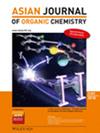Fenton‐Like Catalysis: Fe(III)/H2O2‐Mediated Oxidative Scission of Ascorbic Acid to a Sustainable One‐Carbon Approach for Aza‐Heterocycle Synthesis
IF 2.7
4区 化学
Q1 CHEMISTRY, ORGANIC
引用次数: 0
Abstract
We report a sustainable and efficient strategy for the synthesis of aza‐heterocycles via oxidative C─C bond cleavage of naturally occurring L‐ascorbic acid, utilized as a renewable one‐carbon (C1) synthon. The transformation is promoted by a Fenton‐like Fe(III)/H2O2 catalytic system and exhibits broad functional group tolerance. A wide variety of substituted o‐aminobenzamides were successfully converted into quinazolinone derivatives in moderate to excellent yields. Additionally, other aza‐heterocycles derived from ortho‐substituted anilines were synthesized in moderate yields. The practicality of this protocol was further demonstrated through a one‐pot synthesis starting from isatoic anhydride 1′ and aromatic amines, along with successful gram‐scale reactions. Radical inhibition experiments with TEMPO and control studies in the absence of o‐aminobenzamide support a radical‐mediated oxidative pathway. Furthermore, the in situ formation of glyceraldehyde as a key C1 intermediate was confirmed by HRMS, providing support for the proposed mechanism. Thus, this method offers an economical and scalable route for the construction of valuable nitrogen‐containing heterocycles from bio‐based feedstocks.

Fenton-Like催化:Fe(III)/ h2o2介导的抗坏血酸氧化裂解为可持续的单碳氮杂环合成方法
我们报道了一种可持续和有效的策略,通过氧化C─C键裂解天然存在的l -抗坏血酸,利用可再生的一碳(C1)合成氮杂环。这种转化是由类似fenton的Fe(III)/H2O2催化体系促进的,并表现出广泛的官能团耐受性。各种取代的邻氨基苯酰胺以中等至优异的收率成功地转化为喹唑啉酮衍生物。此外,还以中等产率合成了邻取代苯胺衍生的氮杂环化合物。通过从异核酸酐1 '和芳香胺开始的一锅合成,以及成功的克级反应,进一步证明了该方案的实用性。在没有邻氨基苯甲酰胺的情况下,TEMPO的自由基抑制实验和对照研究支持自由基介导的氧化途径。此外,HRMS证实了甘油醛作为关键的C1中间体的原位形成,为所提出的机制提供了支持。因此,该方法为从生物基原料中构建有价值的含氮杂环提供了一条经济且可扩展的途径。
本文章由计算机程序翻译,如有差异,请以英文原文为准。
求助全文
约1分钟内获得全文
求助全文
来源期刊

Asian Journal of Organic Chemistry
CHEMISTRY, ORGANIC-
CiteScore
4.70
自引率
3.70%
发文量
372
期刊介绍:
Organic chemistry is the fundamental science that stands at the heart of chemistry, biology, and materials science. Research in these areas is vigorous and truly international, with three major regions making almost equal contributions: America, Europe and Asia. Asia now has its own top international organic chemistry journal—the Asian Journal of Organic Chemistry (AsianJOC)
The AsianJOC is designed to be a top-ranked international research journal and publishes primary research as well as critical secondary information from authors across the world. The journal covers organic chemistry in its entirety. Authors and readers come from academia, the chemical industry, and government laboratories.
 求助内容:
求助内容: 应助结果提醒方式:
应助结果提醒方式:


